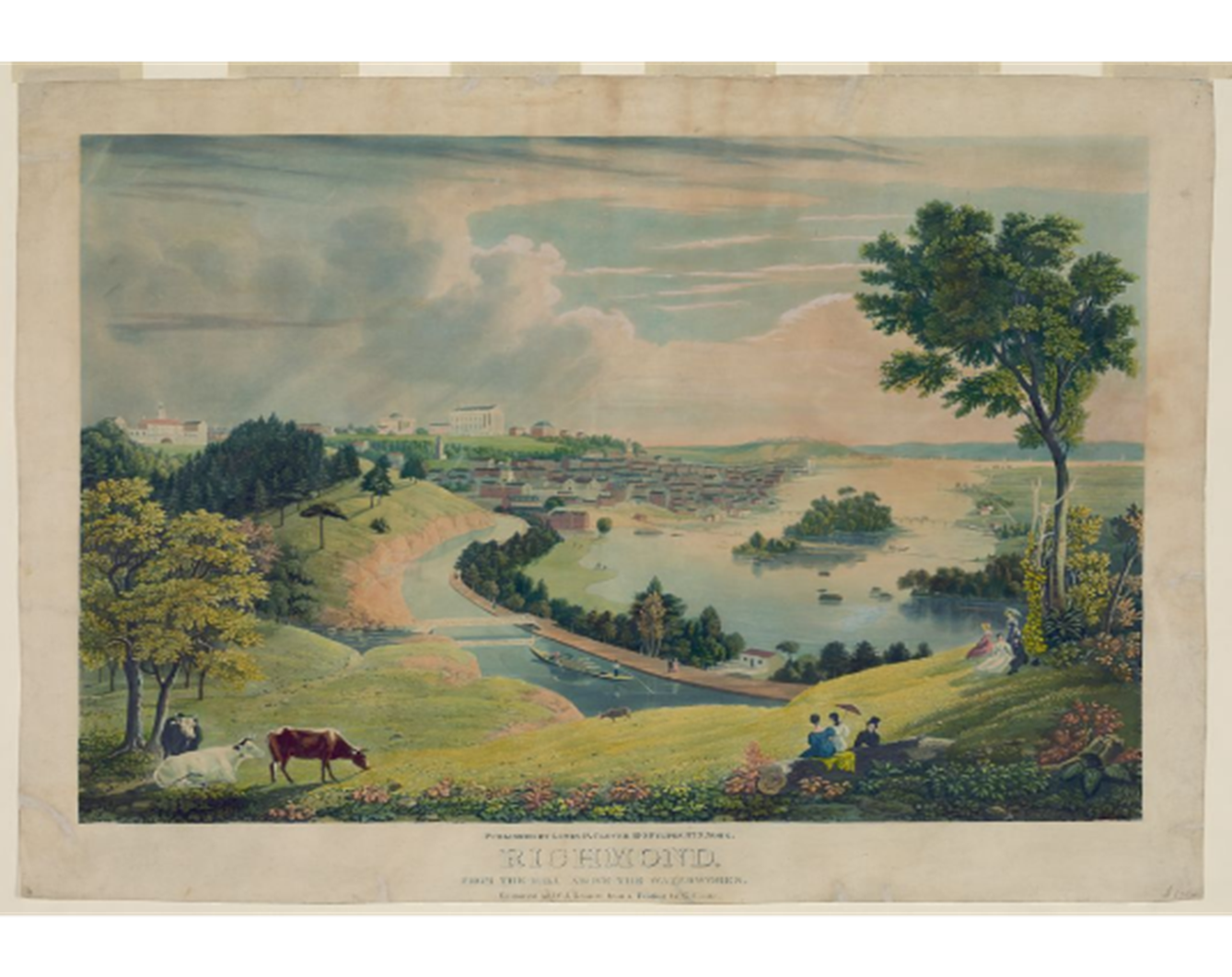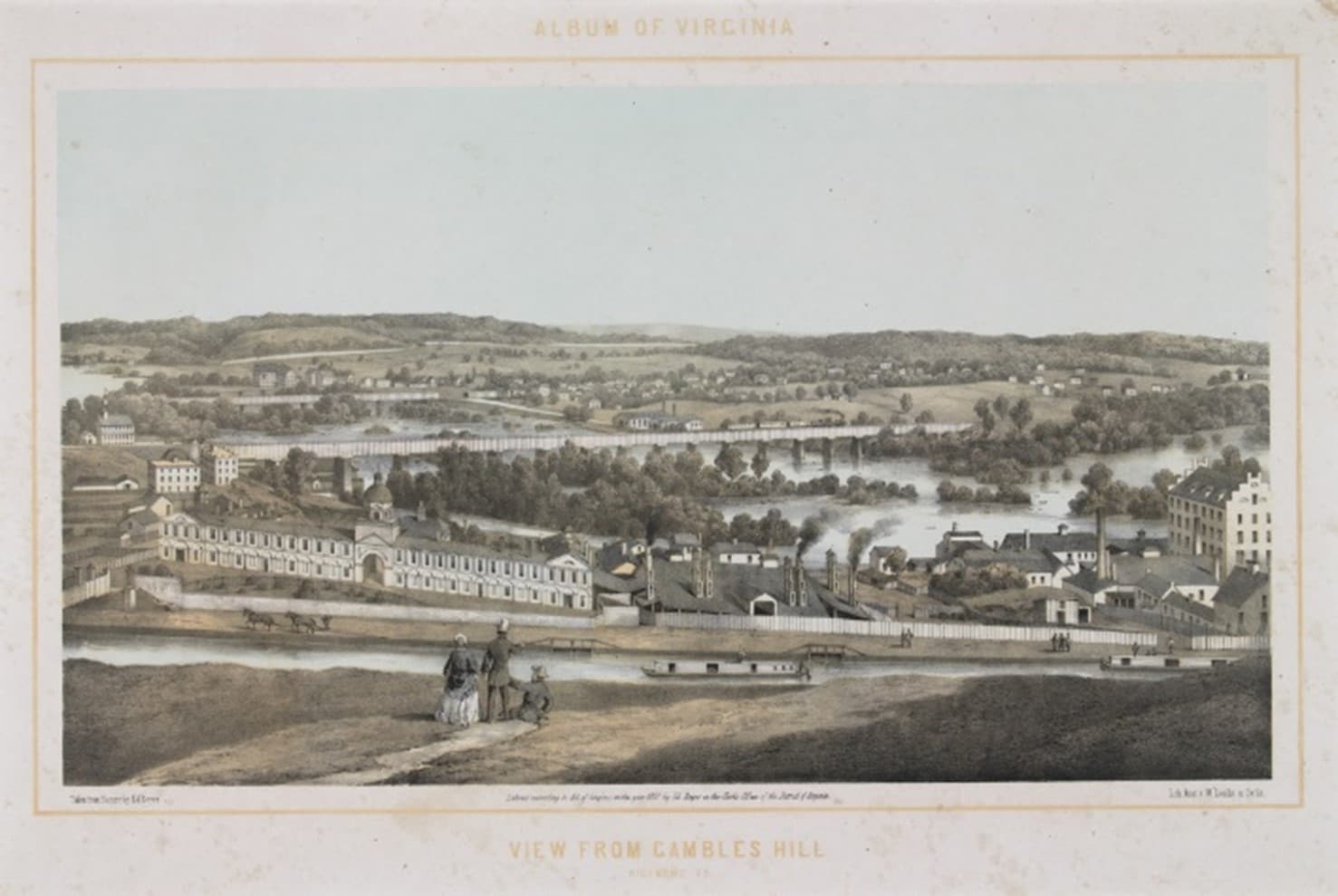Landscape and Urban Changes
To start, I want to show how artists interpreted this change in the city through landscape art. The factories, smokestacks, and railroads altered the natural scenery and while some embraced the technological advancements, others mourned the loss of green space. We’ll compare illustrations from artworks, a few decades apart, that really shows the fast changes in the landscape.
Beginning with William James Bennet (1787-1844), a British-born artist known for his landscape art, he painted Richmond, from the Hill Above the Waterworks in 1834. At the foreground of the painting, we see gentle, slopping hills, with lush trees and shrubs creating a natural frame. We see a small group of well-dressed people, inferring that they are prosperous members of the bourgeoisie, lounging leisurely, adding to the serenity of the scene. In the middle ground, we see the calming flow of the James River. The surface of the water is reflecting the sky and surrounding landscape. The river serving as a natural boundary between the rural and urban environments. In the distance we see the city of Richmond; buildings, homes, churches, and other structures that reflect the style of the time. The artist is careful to delineate key landmarks, such as the classical architecture of the Virginia State Capitol, inferring Richmond’s political power. The colors in this painting have a light, natural color palette with greens and blues dominating the space. Bennet perfectly captures what Richmond looked like right as the city is starting to industrialize.

Fig. 3 [Bennett, W. J. , Engraver, and G Cooke. Richmond, from the hill above the waterworks / engraved by W.J. Bennett from a painting by G. Cooke. Virginia James River Richmond, ca. 1834. New York: Published by Lewis P. Clover. Photograph. https://www.loc.gov/item/96510852/.]
Another telling example of a landscape painting of Richmond is Views of Richmond, Virginia8 by an unknown artist painted in 1835. In this painting we see a different point of view of the James River, but a very similar landscape to Bennet’s interpretation. Again, we see a picturesque image of the time complete with trees, hills, and wealthy strollers leisurely enjoying nature, and the state capitol building standing tall in the background. The natural lighting and green foliage remind us of Richmond before industrialization.
Edward Beyer (1820-1865) was a German-born artist who traveled through the Antebellum South during the height of the Industrial period and is known for his landscape and panoramic art. From 1857-1858, Beyer traveled across Virginia creating a portfolio of 41 lithographic views called Album of Virginia. In 1857, he painted, View from Gambles Hill, Richmond, VA, where he shows us a now industrial Richmond. Like Bennet’s perspective, upfront we see trees, shrubs, and a grassy area. A group of well-dressed, presumably upper-class, people are engaging in activity, either walking or admiring the view from the hill. In the middle we see an industrial zone. The James River is still a focal point, but now we see flour mills, tobacco factories, arsenals, and even the Tredegar Iron Company off to the right side of the frame. In the distance we see two newly constructed railroad bridges that span the river. The smokestacks coming from these factories add to the discoloration of the painting, no longer showing a green, natural landscape, but a city being transformed into an urban space. We also want to take the time to reflect on who created this through unseen and unrecognized labor; enslaved people. Reflecting on the hard work that was put into the city cannot be understood without fully understanding that enslaved people would most likely not be allowed to be visible at this time, but contributed so much to Richmond.

Fig. 4 [View from Gambles Hill, Richmond, VA, from “Album of Virginia”. 1857, by Edward Beyer, Virginia Museum of Fine Arts)
As more and more people started immigrating into the city to find jobs in the factories, we start to see a burgeoning cityscape with crowded streets and a stark contrast between the wealthy and working class. Frances Benjamin Johnston9 (1864-1952), a Virginian native, was one of the first American female photographers to help capture these urban societal changes by photographing the daily lives of workers. Her pictures often had a social reform angle by using her lens to draw attention to the work conditions of laborers, often African Americans, and drawing attention for the need of improved working conditions.

Comments: